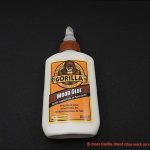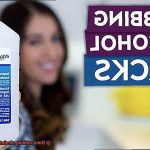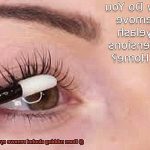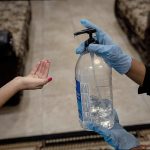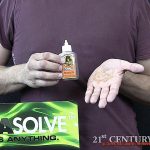Imagine this: you’re innocently working on a project when disaster strikes. A glob of super glue lands on your skin or, worse yet, your favorite possession. Panic sets in as you contemplate the damage that could be irreversible. But fear not, my friend, because there might just be a surprising hero lurking in your pantry – peanut butter.
Yes, you heard it right. The internet is buzzing with claims that our beloved peanut butter has some kind of mystical power to remove super glue. But can this gooey goodness really save the day? In this blog post, we’re diving headfirst into the peanut butter phenomenon, separating fact from fiction and unraveling the science behind it all.
So grab yourself a jar of creamy or crunchy (your choice.), a trusty knife, and get ready to embark on an adventure to discover whether peanut butter truly has what it takes to loosen the unyielding grip of super glue.
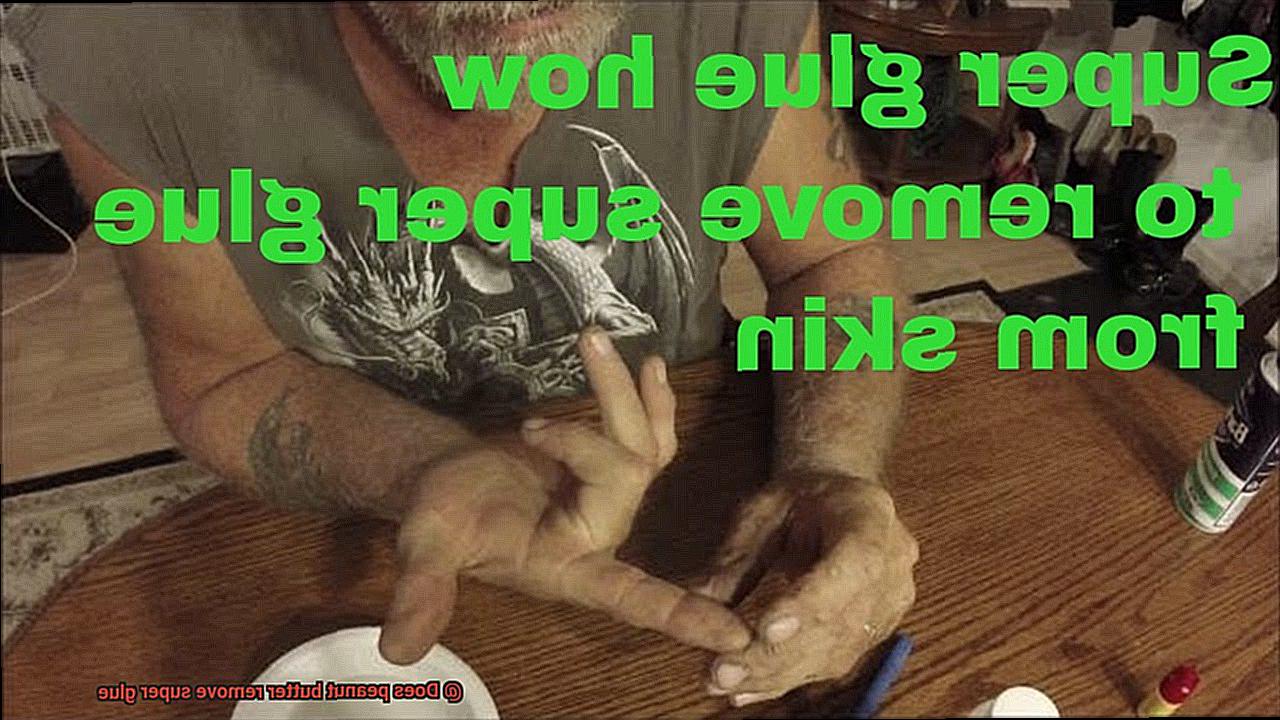
Get ready for a battle between two sticky adversaries as we determine once and for all if peanut butter is indeed the superhero we never knew we needed when faced with our stickiest situations. Are you ready? Let’s dive in and find out.
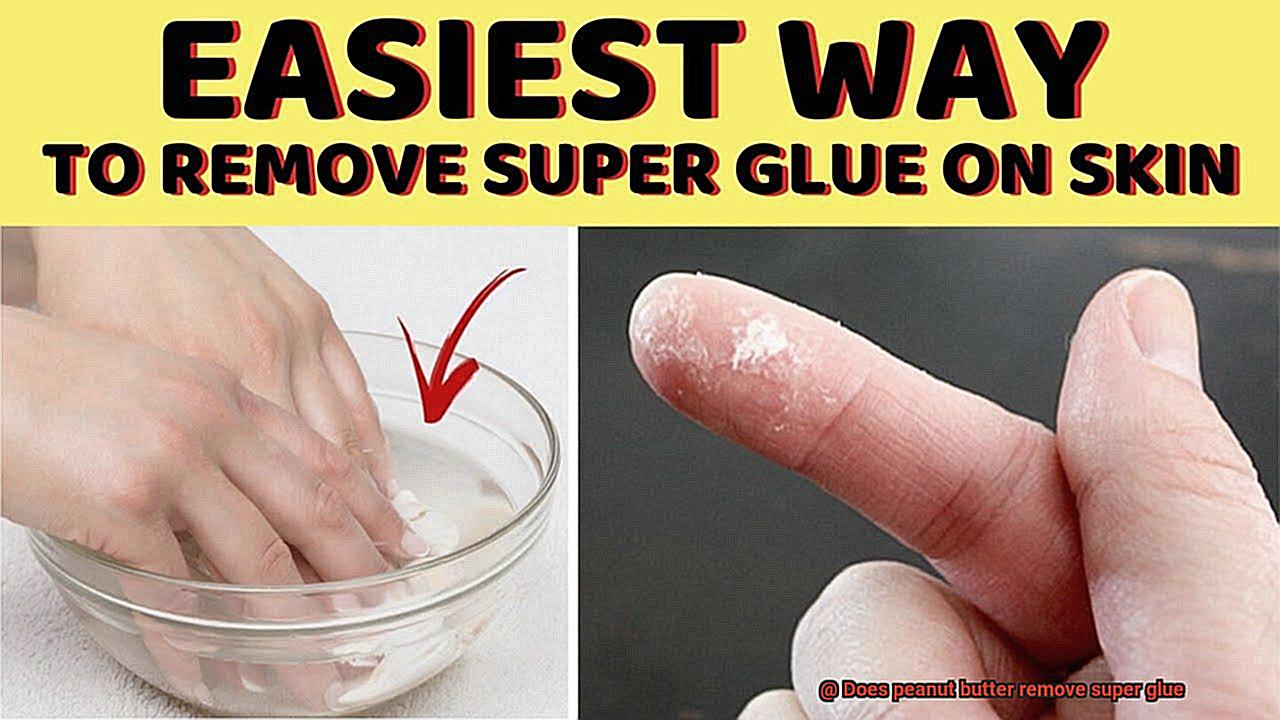
How does super glue work?
Contents
- 1 How does super glue work?
- 2 Why peanut butter might work
- 3 How to use peanut butter to remove super glue
- 4 Anecdotal evidence: Success stories with peanut butter
- 5 Potential drawbacks and limitations of using peanut butter
- 6 Alternatives to using peanut butter
- 7 Safety precautions when using alternative methods
- 8 Conclusion
Super glue, also known as cyanoacrylate adhesive, possesses the remarkable ability to bond an array of materials together, ranging from metal to rubber and even human skin. But have you ever pondered over the wizardry that allows this adhesive to work its magic? In this captivating exploration, we will delve into the chemistry behind super glue and unveil the factors that contribute to its widespread popularity as a bonding agent.
Chemical Composition and Reaction:
At its core, super glue comprises a group of compounds known as cyanoacrylates, which are derived from the cyanoacrylic acid family. Initially stored in a liquid state within its container, super glue undergoes a fascinating transformation upon application. When exposed to moisture present in the air or on the material itself, a rapid polymerization process is triggered, causing the liquid cyanoacrylates to solidify into resilient polymers.
Swift and Secure Bond:
The swiftness and reliability of super glue’s bond lie in this polymerization process. As the cyanoacrylate molecules link together to form elongated chains, they create an intricate network of bonds between the surfaces being joined. Remarkably, this reaction occurs at room temperature without requiring additional heat or catalysts, making super glue an incredibly convenient adhesive option.
Adhesive Properties:
The robust bonds forged by super glue are a result of intermolecular forces established between the solidified polymers and the surface molecules of the materials being bonded. These encompass van der Waals forces and dipole-dipole interactions, which effectively anchor the glued surfaces together, ensuring their longevity.
Factors for Optimal Results:
Achieving optimal results with super glue necessitates working with meticulously clean and dry surfaces. Any presence of moisture, oil, or dirt can disrupt the polymerization process and weaken the bond. To ensure success, it is advised to thoroughly clean and prepare the surfaces prior to application.
Versatility and Convenience:

Super glue’s low viscosity endows it with unparalleled adhesive properties. Its fluid consistency enables it to permeate even the tiniest fissures and crevices, guaranteeing a robust bond even in hard-to-reach areas. Consequently, super glue becomes an invaluable tool for repairing delicate objects or bonding minuscule components together.
Why peanut butter might work
In the face of a sticky situation with super glue, fear not. I present to you an unexpected yet remarkably effective solution – peanut butter. Yes, you read that right. This unassuming pantry staple might just hold the key to effortlessly breaking down those stubborn bonds. Prepare to dive into the fascinating science behind why peanut butter works its magical charm on super glue.
The Power of Natural Oils and Fats:
Within the confines of a jar of peanut butter lie natural oils and fats that possess incredible adhesive properties. These remarkable components have the ability to dismantle the chemical bonds within super glue, rendering it vulnerable and easy to remove from surfaces. Picture these oils as tiny superheroes, infiltrating the super glue and gently softening it, thus facilitating a smoother removal process.
The Sticky Texture Advantage:
Peanut butter doesn’t just harness the power of oils; its sticky texture plays a pivotal role in the removal process as well. When applied to super glue, this delightful spread adheres to it tenaciously, providing a superior grip for easier removal. Its inherent stickiness ensures that the peanut butter remains in contact with the super glue for an extended period, allowing it ample time to work its magic.
Safe and Non-Toxic:
One of the most commendable aspects of using peanut butter as a super glue remover is its safety. Unlike harsh chemicals or specialized solvents, peanut butter is non-toxic and poses no harm to children or pets. So, even if you accidentally get some on your hands or furniture, rest assured that there is no cause for alarm.
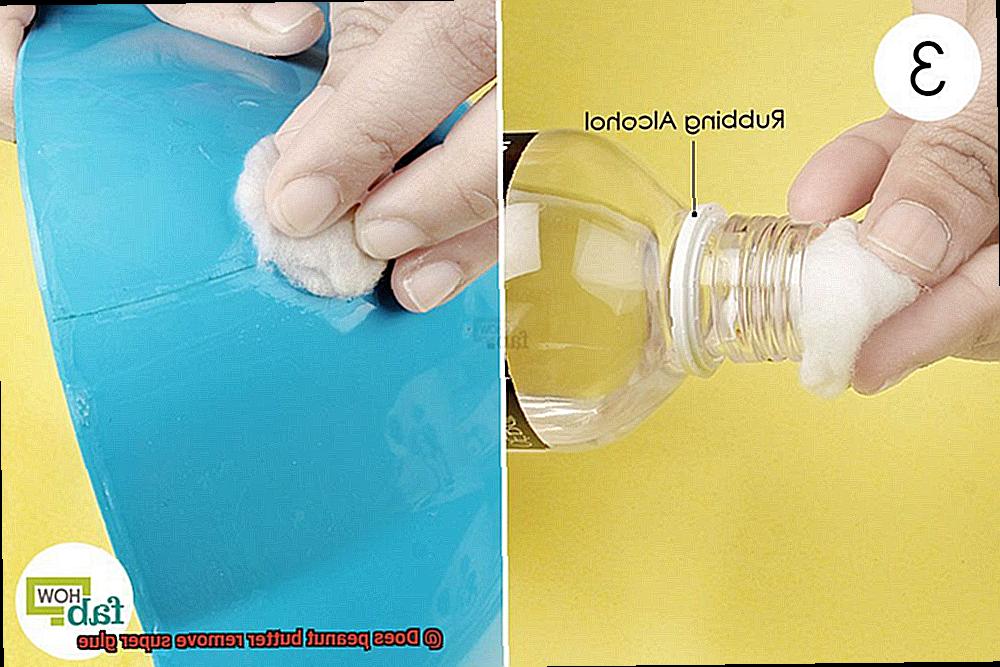
Affordable and Accessible:
Another advantage of employing peanut butter as your secret weapon against super glue is its accessibility and affordability. Chances are, you already have a jar of this delectable spread in your kitchen cupboard. So, before rushing out to purchase expensive specialized removers, why not give peanut butter a chance? It offers convenience without breaking the bank.
Effective on Various Surfaces:
While the efficacy of peanut butter may vary depending on the type of super glue and the surface it has bonded with, it has exhibited promising results on an array of materials. Whether it’s glass, plastic, or even wood, peanut butter’s natural solvents can deftly soften super glue, making it a breeze to scrape or peel off without causing any damage.
How to use peanut butter to remove super glue
Accidentally getting super glue on your favorite item can be a nightmare. But fear not, because there’s a natural solution that might just save the day – peanut butter. Yes, that delicious snack sitting in your pantry can actually help break down the strong adhesive properties of super glue. In this guide, we’ll explore step-by-step how to use peanut butter to remove super glue from different surfaces. So let’s dive in and discover the magic of peanut butter.

Gather your materials:
Before you begin, make sure you have everything you need. Grab a jar of peanut butter (smooth or crunchy), a soft cloth or sponge, warm water, and soap. Having all your materials ready beforehand will ensure a smooth process.
Apply the peanut butter:
Take a generous amount of peanut butter and apply it directly onto the super glue. Make sure to cover the entire area affected by the glue. The oils in peanut butter work like superheroes, attacking the adhesive properties head-on.
Let it sit:
Allow the peanut butter to work its magic for about 10-15 minutes. During this time, the oils will penetrate the glue, weakening its hold on the surface.
Rub gently:
After the waiting period, take a soft cloth or sponge and gently rub the peanut butter into the glue. The goal is to create friction and work the peanut butter deep into the glue, further weakening its adhesion. As you rub, keep an eye out for signs of progress.
Rinse with warm water:
Once you see that the super glue is starting to loosen, rinse the area with warm water to remove any remaining peanut butter residue. You can also use a mild soap to ensure that all traces of both the super glue and peanut butter are gone.
Dry and inspect:
Finally, dry the area thoroughly with a clean cloth or towel. Take a close look at the surface to ensure that all traces of super glue have been successfully removed. If necessary, repeat the process until all remnants of super glue are gone.
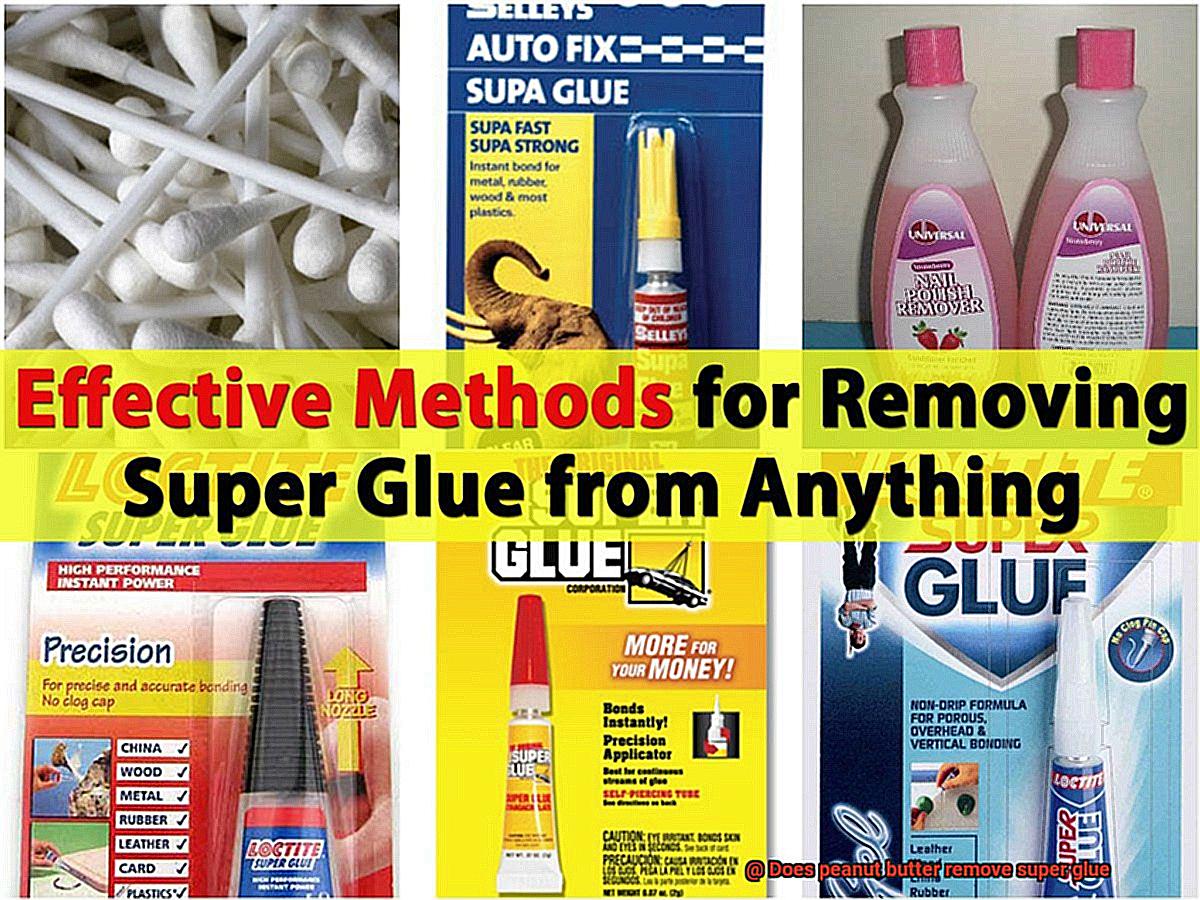
Anecdotal evidence: Success stories with peanut butter
We all experience super glue mishaps, leaving our fingers glued together or our cherished items permanently stuck.
In this captivating blog post, we embark on a journey into the enchanting world of peanut butter and its astonishing success stories as a superhero in the battle against super glue.
From freeing skin to rescuing prized possessions, peanut butter has proven to be an unexpected and effective solution. Join us as we explore these anecdotes and discover how this humble spread can save the day.
Peanut Butter’s Magic Touch on Skin
Let’s begin with one of the most popular success stories involving peanut butter’s heroic powers to remove super glue from skin. Users swear by applying a generous amount of peanut butter onto the affected area and gently massaging it to break down the adhesive properties of the glue.
The natural oils and fats present in peanut butter work their magic by loosening the bond, allowing for easy removal without any harm to the skin.
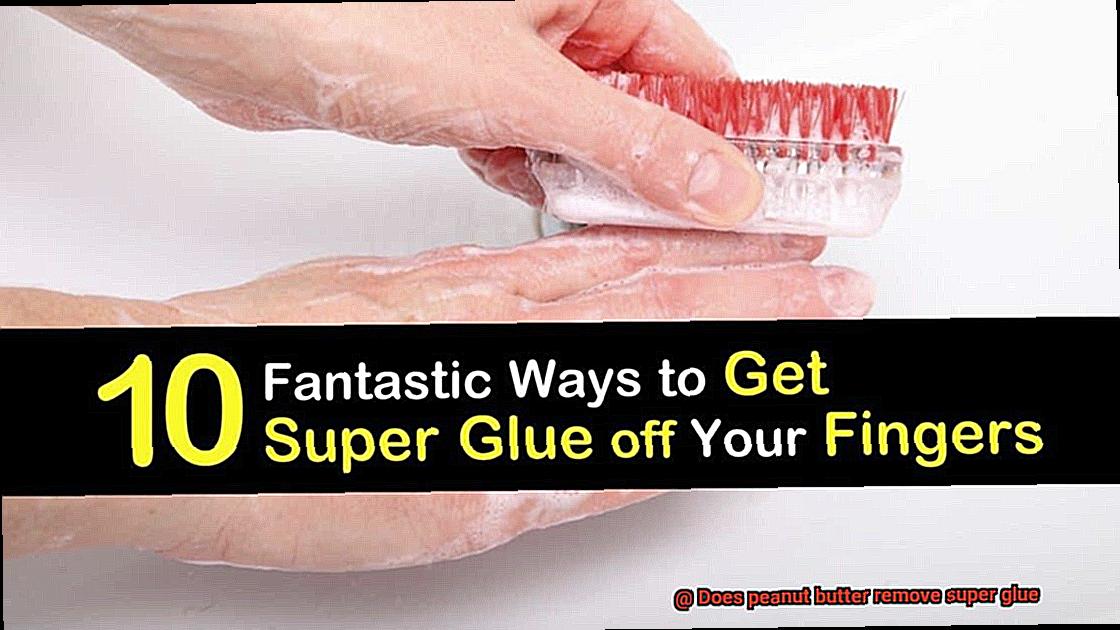
Peanut Butter Comes to the Rescue of Surfaces
But peanut butter’s superhero abilities don’t stop at skin. Countless anecdotes suggest that spreading a thin layer of peanut butter onto super glue-covered surfaces, like countertops or clothing, can soften the adhesive grip.
Simply allow it to sit for a few minutes before gently scrubbing with a soft cloth or sponge to witness the miracle of peanut butter lifting off the glue residue, leaving your surfaces looking brand new.
The Caveat: Use with Caution
While peanut butter’s success stories are thrilling, it’s crucial to approach them with caution. Anecdotal evidence may vary depending on factors such as the type of super glue used and the surface it is applied to.
It is advisable to test peanut butter on a small, inconspicuous area first before proceeding with larger applications. Remember, not all situations may warrant the use of peanut butter as the ultimate solution.
Potential drawbacks and limitations of using peanut butter
In our relentless pursuit to conquer the tenacious grip of super glue, we often seek unconventional solutions. Enter peanut butter – a pantry staple that promises to be the superhero in this sticky battle. But before you reach for that jar, it’s crucial to explore the potential drawbacks and limitations of using peanut butter as a super glue remover.
Allergic Reactions:
Peanut butter, a delectable delight for many, can transform into a nightmare for those with peanut allergies. In the realm of super glue removal, it is vital to prioritize safety. Individuals with peanut allergies should steer clear of using peanut butter as it can trigger anything from mild irritation to severe anaphylaxis, a life-threatening allergic reaction. Let’s ensure we avoid turning our sticky situation into something far more perilous.
Messy Application:
Peanut butter’s innate stickiness can transform the process of super glue removal into a messy affair. Applying peanut butter directly onto the affected area may result in smearing or unintended spreading of the glue, exacerbating the cleanup process. Delicate surfaces or items requiring precise handling may experience unintentional damage during this endeavor.
Time-Consuming Process:

Patience becomes paramount when employing peanut butter as a super glue remover. The glue necessitates time to soften and disintegrate, which can span several hours or even an entire night. If you find yourself in dire need of a quick fix or immediate removal, peanut butter may not be the most efficient option at your disposal.
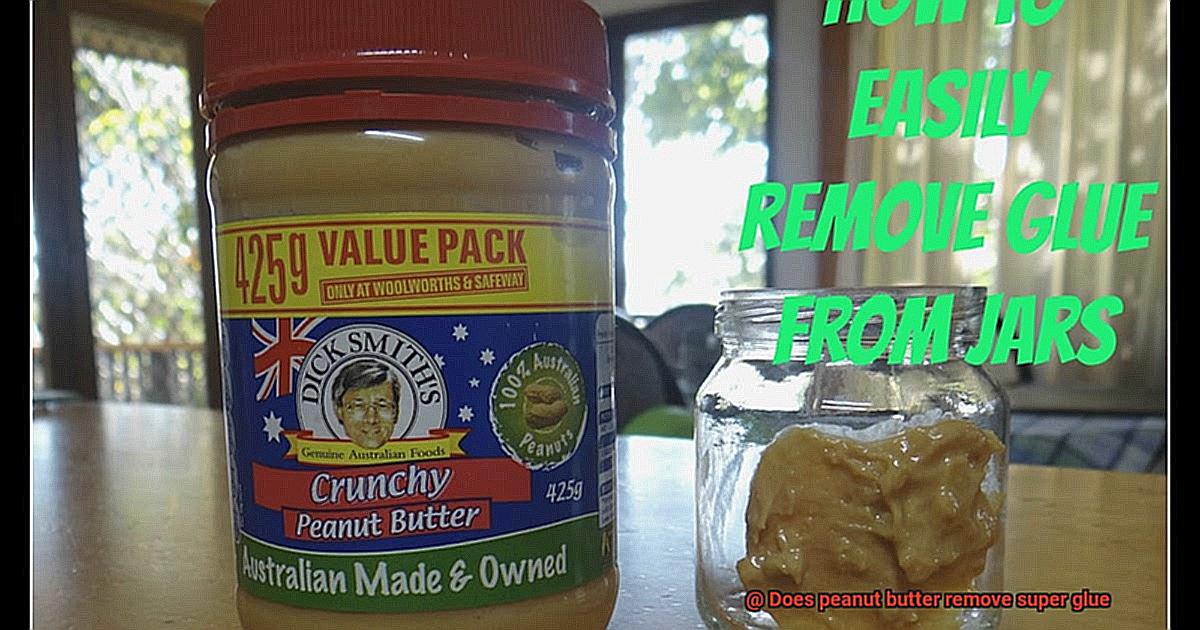
Ineffectiveness on Certain Surfaces:
While peanut butter triumphs in obliterating super glue from materials like plastic or glass, its prowess falters when confronted with porous surfaces such as fabric or wood. The adhesive struggles to infiltrate or dissolve on these intricate surfaces. Moreover, the oil content of peanut butter may leave behind unsightly residues or even stain susceptible materials, thus potentially compounding the damage.
Difficulty in Precise Application:
When dealing with diminutive or intricate objects, precision reigns supreme. However, achieving precise application of peanut butter to the desired area proves to be an arduous task due to its viscous nature. The result? Unwanted contact with surrounding areas or objects, further aggravating the already vexing process of super glue removal.
Odor and Cleanliness Concerns:
Let us not forget the distinctive aroma that accompanies peanut butter. While some may find it delightful, others may deem it overpowering. Working in enclosed spaces or near food preparation areas can transform the lingering odor into a less-than-pleasant experience. Additionally, eliminating the remnants of peanut butter requires thorough scrubbing and multiple washes to vanquish all traces of stickiness or grease.
Alternatives to using peanut butter
We’ve all experienced that moment of dread when super glue becomes an unwanted permanent fixture. While peanut butter has long been hailed as the go-to solution, there are numerous alternatives that can effectively remove super glue.
In this post, we will explore the benefits and drawbacks of acetone, rubbing alcohol, citrus-based solvents, and warm soapy water as potent alternatives to peanut butter. Let’s dive in and find the perfect remedy for your sticky situation.
Acetone:
As a powerful solvent commonly found in nail polish removers, acetone is a top contender for dissolving super glue. By breaking down the chemical bonds of the adhesive, it makes removal easier. However, caution must be exercised as acetone can be harsh on certain surfaces, potentially causing discoloration or damage. Always test on a small, inconspicuous area before applying it more extensively.
Rubbing Alcohol:
Another effective alternative is rubbing alcohol, also known as isopropyl alcohol. This substance dissolves super glue without harming most surfaces. For optimal results, seek rubbing alcohol with a high concentration (at least 90%) and apply it using a cotton ball or cloth to gently rub the affected area until the glue loosens.
Citrus-Based Solvents:
For those preferring natural alternatives, citrus-based solvents such as lemon juice or orange oil can come to the rescue. The acidic properties of these fruits aid in breaking down the adhesive bonds of super glue. Not only are these natural alternatives generally safe to use, but they also pose little risk to surfaces or skin. Simply apply lemon juice or orange oil onto a cloth or cotton ball and gently rub until the glue starts to dissolve.
Warm Soapy Water:
If you desire a gentler approach, warm soapy water proves surprisingly effective at removing super glue. By soaking the affected area and gently scrubbing with a cloth or sponge, the adhesive gradually loosens and can be easily removed. This method is safe for most surfaces and eliminates the need for harsh chemicals.
Safety precautions when using alternative methods

We’ve all experienced that heart-stopping moment when we accidentally find super glue on our fingers or discover it stubbornly stuck to an inappropriate surface. Thankfully, alternative methods like peanut butter, acetone, or warm soapy water can come to the rescue.
However, it’s vital to prioritize safety when employing these alternatives. In this engaging blog post, we will explore the essential safety precautions you should follow when using these methods to remove super glue. Let’s dive in and learn how to tackle that sticky situation while staying safe.
Shield Your Skin and Eyes:
Super glue can cause irritation and burns if it comes into contact with your skin or eyes. To avoid any mishaps, always wear protective gloves and safety goggles when working with super glue or alternative methods. These simple precautions will safeguard your sensitive areas, preventing accidental exposure and potential harm.
Opt for a Well-Ventilated Workspace:
Some alternative methods may emit strong odors or fumes that can be harmful if excessively inhaled over time. Ensure you work in a well-ventilated area by opening windows or doors. Fresh air circulation will minimize the risk of respiratory issues, creating a more pleasant experience overall.
Heed the Instructions:
Different alternative methods may have specific instructions or precautions outlined by the manufacturer. Take the time to read and understand these instructions before utilizing any alternative method. Ignoring or disregarding them could lead to undesirable outcomes or accidents. So, remember to follow the guidelines for safe and effective use.
Prioritize Prompt Medical Attention:
In rare cases, individuals may experience allergic reactions or adverse effects when using alternative methods. If you accidentally ingest the substance or encounter any unusual symptoms, seek immediate medical attention. It’s always better to be safe than sorry.
Keep Out of Reach from Curious Hands and Paws:
Safety should be our utmost concern, especially when it comes to our loved ones. Store alternative methods and super glue in a secure place where children and pets cannot access them. Ingestion or improper use can be harmful, so let’s keep these substances out of reach to avoid any accidents.
_59ZzuLJcTw” >
Also Read: How To Remove Glue From Hands?
Conclusion
In conclusion, peanut butter has proven to be an effective solution for removing super glue.
Its sticky consistency and natural oils work together to break down the adhesive properties of the glue, allowing for easy removal. Whether you’ve accidentally glued your fingers together or need to remove a stubborn sticker residue, peanut butter can come to the rescue.
Simply apply a generous amount of peanut butter to the affected area and let it sit for a few minutes. Then, gently rub or peel off the softened glue with a cloth or your fingers.
It’s important to note that not all types of super glue may respond as effectively to peanut butter, so it’s always best to test it on a small inconspicuous area first. Additionally, make sure to thoroughly clean the surface after removing the glue residue.
Peanut butter not only offers a practical solution but also adds an element of fun and quirkiness to the process.


